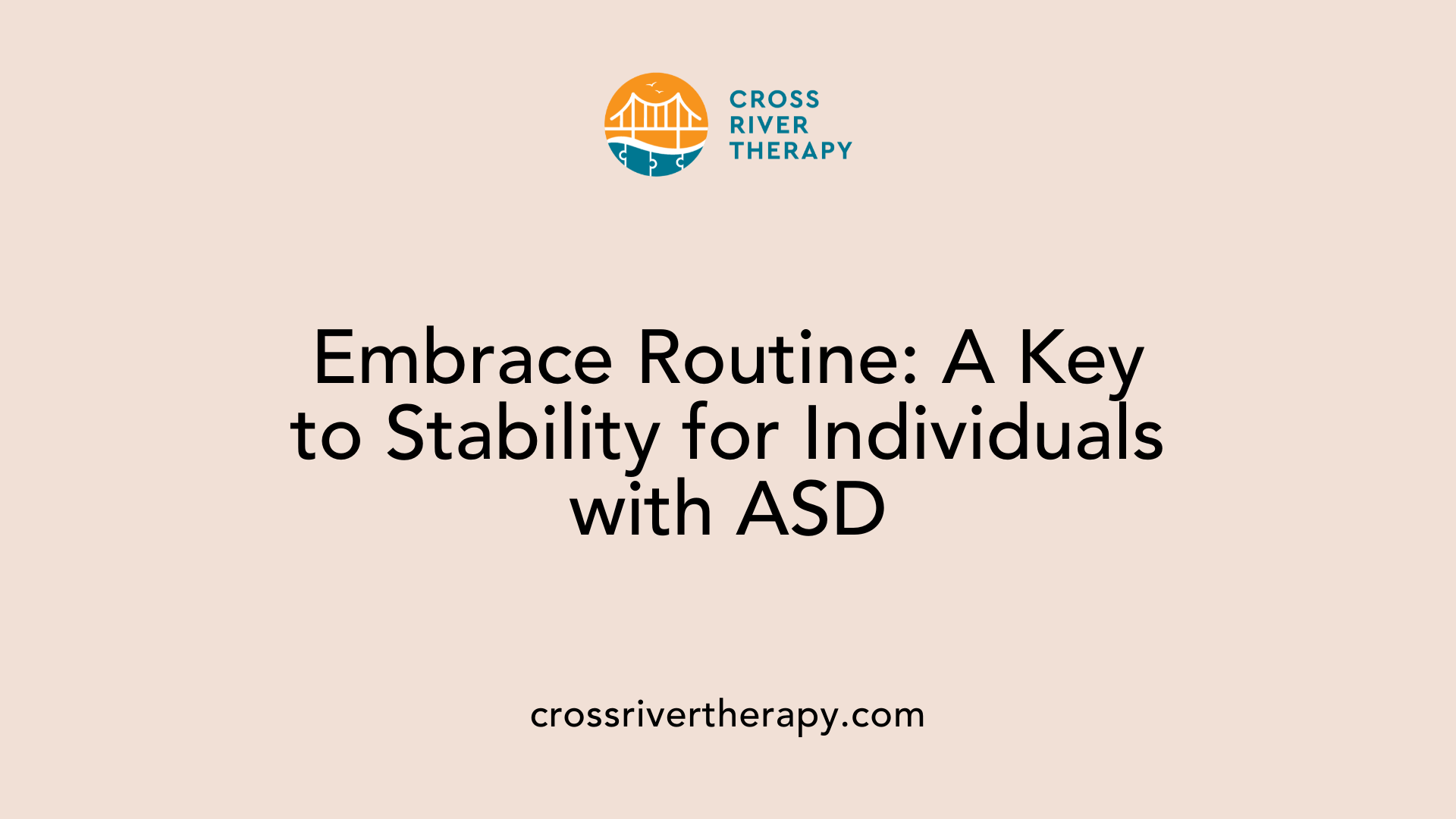Daily Routines for Autism
Creating Structured Daily Routines for Improved Well-being
Understanding the Role of Routines
For individuals with Autism Spectrum Disorder (ASD), routines are more than just scheduled activities — they are essential frameworks that provide stability and reduce anxiety. A well-structured routine helps children with autism understand their day, fostering independence and enhancing their emotional and developmental health. This article explores strategies, benefits, and the significance of tailoring routines to support the unique needs of autistic children.
The Importance of Consistent Routines

Why is routine important for individuals with Autism Spectrum Disorder (ASD)?
Routine is important for individuals with Autism Spectrum Disorder (ASD) because it provides predictability and structure, which are crucial for reducing anxiety and helping them feel safe in their environments. A consistent daily schedule allows individuals with ASD to anticipate daily events, fostering a sense of control and stability.
Key Benefits of Routines:
- Predictability: Knowing what to expect throughout the day alleviates stress and builds confidence.
- Enhanced Stability: A structured routine creates a safe environment, making transitions smoother between tasks and activities.
- Emotional Well-Being: Improved emotional regulation allows children to navigate social situations more successfully.
- Independent Functioning: Developing routine strengthens self-care skills and promotes autonomy in daily living tasks.
Visual Aids and Support: Incorporating visual schedules or timers can aid in understanding and following routines effectively. These supports help clarify expectations and enhance cooperation, directly impacting social interaction and learning opportunities.
A consistent daily routine can significantly reduce meltdowns and other challenging behaviors, ultimately fostering better relationships between children with ASD and their caregivers. By emphasizing the importance of routine, families can create an environment where children can thrive and actively engage in their development.
Crafting Effective Daily Routines

Visual schedules and consistency
Creating a daily routine for a child with autism involves integrating visual schedules and ensuring consistency. Visual schedules serve as a powerful tool to communicate what is happening throughout the day, helping children grasp the sequence of events. These can be designed using images or symbols representing each activity, such as brushing teeth, eating breakfast, or getting dressed.
Maintaining consistency in timing is crucial. Children with autism thrive on predictability; knowing exactly when an activity will occur helps alleviate anxiety. By keeping routines the same each day, children develop a sense of security, which enhances their willingness to engage and participate in daily tasks.
Breaking down tasks into manageable steps
To support children effectively, breaking down tasks into manageable steps is essential. For example, morning routines can be segmented into simple actions such as waking up, getting dressed, brushing teeth, and having breakfast. Utilizing visual aids like step-by-step guides or checklists can significantly empower children by providing clear directions.
Additionally, allowing the child to participate in creating their schedule promotes ownership and independence. This process not only makes the routine more engaging but also helps children feel more in control of their environment, facilitating smoother transitions between activities.
Overall, employing practical strategies like visual schedules and manageable steps in routines fosters a positive atmosphere conducive to learning and development for children with autism.
Enhancing Well-being with Structured Routines

Can structured routines improve the wellbeing of autistic children?
Yes, structured routines can significantly improve the wellbeing of autistic children by fostering independence and self-esteem through the mastery of daily living activities such as meal times and self-care. These routines establish a predictable environment which is crucial for helping children manage challenges that arise from sensory and cognitive processing differences.
Role of visual aids and step-by-step instructions
Visual aids and step-by-step instructions play a vital role in instilling confidence and competence in autistic children. Techniques like visual schedules and picture guides break down tasks into manageable steps, making it easier for children to comprehend and follow daily routines. For instance, creating a visual meal prep guide promotes involvement in kitchen activities, allowing children to feel a sense of accomplishment.
Moreover, incorporating timers can help signal transitions, enabling smoother shifts from one activity to another. Engaging children in the creation of their routines not only enhances their understanding but also fosters a sense of ownership over their daily tasks, promoting further independence. The collaboration with family members and therapists also tailors routines to individual preferences, enhancing the overall supportive environment that contributes positively to their emotional and social development.
In summary, structured routines, supported by visual aids and individualized attention, cultivate a nurturing foundation that is beneficial for the overall wellbeing of autistic children.
Routines in Educational Settings
What role do routines play in educational settings for autistic students?
Routines play a vital role in educational settings for autistic students by providing a sense of stability and predictability, which can significantly reduce anxiety and confusion. Many autistic individuals struggle with changes, requiring consistent routines to help them manage transitions effectively and alleviate fear related to unexpected events.
Minor changes can lead to significant distress, while major transitions necessitate thorough preparation. This can include the use of visual supports such as timetables and photos to ease the process. Strategies, like marking changes on calendars and employing clear language about upcoming events, can further aid in this transition.
A well-structured routine combined with supportive practices equips autistic students to focus better on their learning and navigate their educational environment more comfortably. For instance, visual schedules can help clarify what is expected during classroom activities, while activities that incorporate interests may increase engagement.
Managing transitions effectively
To effectively manage transitions, educators can utilize strategies like visual aids and clear, affirming communication. Incorporating sensory-friendly environments can also ease the transition process by minimizing overwhelming stimuli.
Additionally, allowing students to take part in setting daily schedules fosters ownership and empowerment, leading to greater cooperation. Regularly reviewing and adjusting routines ensures they remain relevant to each student's unique needs, thus enhancing their emotional security and confidence within the learning environment.
Individualizing Routines for Unique Needs

How can routines be individualized based on the specific needs of an autistic child?
Routines for autistic children can be tailored to meet their distinctive preferences and interests. By observing what engages a child, caregivers can create a schedule that encourages participation and enthusiasm. For instance, if a child has a particular affinity for a subject or activity, incorporating that into their daily routine can make tasks more enjoyable and meaningful.
Additionally, addressing mental health needs is critical. Many autistic children experience anxiety and depression; thus, routines should include calming techniques such as deep breathing, sensory play, or designated downtime. Creating a ‘calm down corner’ with soothing items can enhance emotional regulation and resilience.
Social interactions also play a vital role in mental wellness. Scheduling opportunities for friendships or peer engagement can help combat feelings of isolation or bullying, which autistic children may be more prone to face. It’s important to collaborate with healthcare providers to ensure that any additional mental health challenges are recognized and integrated into the routine.
Lastly, ongoing education and resources from autism organizations, like the Autism Society, are invaluable. They offer insights and best practices for designing adaptive routines that promote the overall health and development of autistic children, helping them thrive both at home and in other settings.
Overcoming Challenges and Building Flexibility

Dealing with changes and transitions
Changes in routines can be particularly challenging for children with autism, often leading to increased stress and anxiety. To help them navigate these transitions, it’s essential to prepare in advance. Gradual introductions of changes can be effective; for instance, discussing the upcoming change a few days ahead can provide the child with time to adjust. Incorporating coping strategies, such as deep breathing or using a calming corner, can also mitigate excessive anxiety during transitions.
Use of visual supports and coping strategies
Visual supports like timers, social stories, and visual schedules play crucial roles in easing transitions for autistic children. These tools help clarify when changes will occur and outline the sequence of activities. For example, a visual countdown can signal the end of a preferred activity and prepare the child for what’s next.
Additionally, reinforcing flexibility through gentle encouragement and celebrating successful transitions fosters resilience. Regular reviews and adjustments to routines ensure that they remain relevant to the child’s evolving needs, making it easier for them to adapt while minimizing feelings of uncertainty.
Morning Routines: Starting the Day Right
Creating a Calming Morning Routine
Establishing a morning routine that minimizes stress can greatly benefit children with autism. To start, consider incorporating calming activities such as deep breathing or listening to soft music. Additionally, creating a soothing atmosphere using dim lighting and reducing loud noises can ease sensory sensitivity. Early preparation is key; involve your child by allowing them to select clothes the night before, reducing morning chaos and promoting independence.
Building Independence and Engagement
Visual schedules are effective tools that can clarify and outline morning tasks, such as brushing teeth or preparing breakfast. Using pictures and a step-by-step approach makes it easier for children to engage with their routine. Setting timers can encourage focus and provide a clear transition signal between activities, reinforcing positive behavior. Furthermore, introducing fun elements, like a dance break, can keep mornings enjoyable and motivate the child to participate actively.
The Impact of Well-established Routines
Implementing structured daily routines can drastically enhance the lives of children with autism by providing them with the stability and predictability they need to thrive. From improving their social-emotional skills to encouraging independence, routines are a cornerstone in supporting the unique developmental needs of autistic individuals. By tailoring routines to fit individual preferences, utilizing visual aids, and fostering flexibility, caregivers can create a nurturing environment that supports growth and well-being. With continued research and collaboration with professionals, families can ensure that routines remain dynamic and supportive tools in the journey towards a fulfilling life for children with autism.
References
- Tips to Create a Routine for a Child with Autism - Spectrum of Hope
- Establishing Routines at Home | Marcus Autism Center
- How to Set Daily Routine Expectations - Autism Learning Partners
- Understanding the Importance of Consistency in Autism
- Activities for daily living | The Spectrum
- Why Children with Autism Need Routines at Home
- Here's Why an Autism Routine is Important
- Changing routines: autistic children and teenagers



